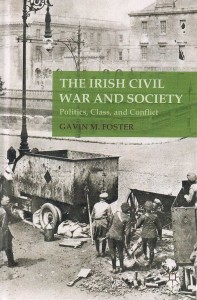The Irish Civil War and society: politics, class, and conflict
Published in Book Reviews, Issue 3 (May/June 2015), Reviews, Volume 23GAVIN M. FOSTER
Palgrave Macmillan
£60
In this latest addition to the historiography of the Civil War, Gavin Foster essentially offers a reconceptualising of class debates. He sets out to explore the social dimensions of the conflict ‘from fresh angles that highlight the rival social outlooks, interests and conflicts that ruptured nationalist solidarity’ at the tail-end of what is perhaps inaccurately referred to as the revolutionary period. In the main he succeeds.
The Civil War, as Foster pithily puts it, has been treated as ‘either a conflict waged over sterile political abstractions or as an essentially apolitical faction fight’. While scholars such as Bill Kissane, John Regan and Anne Dolan have tendered more nuanced readings, there still exists a hegemonic ambivalence towards the conflict, one perhaps articulated by the fact that the Decade of Centenaries does not extend to commemorating the dumping of republican arms in the early summer of 1923 (whatever about the amnesty of November 1924, perhaps a more useful date to mark the cessation of hostilities).
Foster subverts the class debate by examining concepts of ‘respectability’ and this is perhaps a useful lens through which to view the conflict, while more traditional Marxist readings elide the problem presented by the proletarian make-up of the National Army and the non-partisan presence of organised labour on the sidelines. Foster deals with the historiographical debate in his first chapter and successfully builds on the approaches charted by Kissane and Regan, who have to varying degrees covered the same ground.
The second and third chapters examine the mutual social perceptions of the opposing forces, a fascinating exercise which serves to render the legendary animosities more explicable. Foster references pro-Treaty cartoons in which ‘browed, knuckle-dragging republican guerillas’ simulate the Fenian caricatures published in Punch 60 years previously. From the republican perspective, the new National Army uniforms, or more especially those of the Dublin Guard famously dispatched to Kerry, begat the sobriquet ‘Green and Tans’. Where the ‘othering’ of the opposing sides essentially sets the ‘men of no property’ against the ‘stake in the country’ population, the implications for ‘foreign’ activists such as Erskine Childers well exceeded the rhetoric.
The fourth chapter, dealing with the social and political meanings of clothing, places material culture studies into the mix. Theoretically informed by the works of Max Weber and Vilfredo Pareto, Foster does for the top hat what Peter Hart did for the Thompson sub-machine-gun. Here the ‘politics of respectability’ are aptly depicted on a photograph of Cosgrave’s 1922 cabinet which Foster could not resist entitling ‘Dressed to kill’! Fianna Fáil for their part abandoned the top hat, signifying not simply a rejection of Free State notions of respectability but also, as Foster puts it, formulating an ‘alternative respectability’. For the Free State élite the appropriation of the clothing worn by their London counterparts notionally copper-fastened their political legitimacy, but the often raggle-taggle appearance of the rank and file of the National Army remains the dominant photographic image of the conflict. The full implications of that legitimacy were of course underscored by the counter-terror, the atrocities and assassinations which continued after the cease-fire. More trenchant republicans would argue that the repression continued after de Valera’s victory in 1932.
These problematic aspects are covered to an extent in the fifth and sixth chapters, which provide the meat and bones for those unswayed by Foster’s emphasis on respectability. An examination of the varieties of social conflict goes well beyond the normative military narrative, demonstrating a pervasive blurring of the political and social forces at play. As Foster notes, the government’s response to agrarian crime, the distillation of poitín and outbreaks of class conflict was simply to send in the troops, where the unarmed police were reluctant or unable to restore order. Aspects of what would ordinarily be considered class war are treated in a discussion of the activities of the Special Infantry Corps, a force established to deal with the type of agrarian crime and social unrest considered by the government under the catch-all term ‘Irregularism’. While it suited the government to respond to social unrest as part of the fight against insurgency, it is nonetheless interesting that sizeable numbers of ‘wanted Irregulars still at large’ had, by mid- to late 1923, gravitated to the area controlled by the Waterford Command (the epicentre of a major farm labourers’ strike), with 46 individuals located there by Army Intelligence in early November, compared to 21 in Limerick, 22 in Cork and a single individual in Dublin. Foster deals with the problems posed by the occupation of ‘spy farms’, holdings that had been seized by republicans from loyalists and suspected informers during the War of Independence, and notes a reappearance of ‘Captain Rock’ and ‘Captain Moonlight’ in the guise of the ‘Council of the People’s Rights’ and the ‘Silent Avengers’.
Foster’s final chapter on IRA emigration and the social outcomes of the conflict is perhaps the least satisfactory. In the context of the economic depression brought on by the ending of the European war, emigration was not only an option for defeated republicans. The IRA actively discouraged its members from leaving the country, but, as the author admits, it is impossible to quantify the extent to which emigration was a specifically republican phenomenon in the additional context of the demobilisation of the National Army.
Foster’s contribution is a valuable one and it is not a criticism to state that there are potentially two books here. While regional studies dominate contemporary readings, a more national perspective is to be welcomed, one which places less emphasis on the reductive narrative of the conflict’s fostering the binary arrangement which has, until recently, dominated political discourse in the Republic.
Reviewed by
Franc Myles
Franc Myles is an archaeologist with a research interest in the ‘revolutionary period’.

















